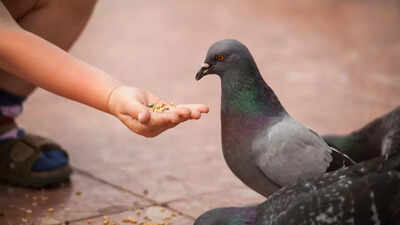Feeding pigeons could harm your health: Know the hidden health risk and awareness tips |

For many people, feeding pigeons is seen as an innocent act of kindness or even a peaceful pastime. However, what appears to be harmless may actually hide serious health risks. Recently, cricket commentator Harsha Bhogle raised concerns on X (formerly Twitter). “Doctors have been shouting from the rooftops about the dangers of inhaling pigeon droppings and the severe lung disease it could lead to”, says Bhogle and urges everyone to stop feeding pigeons. His warning is not without reason. A study published in the Uttar Pradesh Journal of Zoology earlier this year supports Bhogle’s concern with scientific evidence, highlighting the dangers associated with exposure to pigeon droppings and their link to fungal infections that threaten both public health and the environment.
The science behind bird droppings and respiratory diseases
Pigeons have coexisted with humans for centuries, symbolising peace and companionship. Yet, beneath their gentle image lies a biological reality. According to recent zoological research, pigeon droppings serve as a major reservoir for Cryptococcus neoformans, a harmful fungus found in soil and decaying organic matter.
- This microorganism thrives particularly well in soil contaminated with pigeon excreta, where warm, moist conditions encourage fungal growth.
- Once the fungus dries and becomes airborne, the spores can be inhaled, allowing them to enter the lungs undetected.
- Individuals such as zookeepers, pigeon breeders, pet bird owners, and those cleaning ancient monuments or old buildings are most at risk.
While healthy people may experience no symptoms, those with weakened immune systems, especially individuals living with HIV/AIDS or chronic respiratory conditions, are vulnerable to severe infections.
Cryptococcus infection: Silent threat to the lungs
Medical experts have long warned about Cryptococcus neoformans because of its silent yet potentially fatal effects on human health. When the spores are inhaled, they usually settle in the lungs, where the infection can either remain unnoticed or spread throughout the body.
- The condition, known as cryptococcosis, often begins as a mild respiratory infection.
- In some cases, it progresses to affect the central nervous system, leading to cryptococcal meningitis.
- Symptoms may include persistent cough, chest pain, headache, fever, fatigue, and, in severe cases, confusion or blurred vision.
What makes this disease particularly concerning is its ability to remain dormant for long periods before showing signs. Because early symptoms resemble those of common respiratory illnesses, cryptococcosis can often go undiagnosed until it becomes serious.Scientists from the journal point out that the fungus does not grow inside the pigeons themselves, as their body temperature of about 40°C prevents yeast formation. However, their droppings provide an ideal environment for fungal survival, especially once they dry and mix with dust particles that people may unknowingly inhale.
Why experts are urging people to stop feeding pigeons
Pigeons have adapted extraordinarily well to human environments. They thrive in cities, nesting on ledges, monuments, and bridges, often in close proximity to people. But this very adaptability is contributing to a growing public health concern.
- Pigeon droppings accumulate on rooftops, statues, and open spaces, becoming breeding grounds for germs, fungi, and parasites.
- When disturbed, the droppings release spores into the air, increasing the risk of infection for anyone nearby.
- Apart from Cryptococcus neoformans, pigeons can also carry other pathogens, such as Salmonella and Chlamydia psittaci, both of which can cause respiratory diseases in humans.
Feeding pigeons encourages overpopulation, which worsens these problems. Large flocks lead to greater accumulation of droppings, which, in turn, raises the risk of contamination in urban areas. Public health specialists recommend discouraging pigeon feeding in cities, proper cleaning of affected areas, and the use of protective gear when handling bird waste.Urban planners and local authorities are also beginning to address this issue by implementing pigeon control measures, such as limiting nesting spaces, improving sanitation, and educating the public about the potential dangers of close contact with pigeons.
Safe ways to coexist with pigeons: Awareness and hygiene can reduce the risk
Despite their association with peace and beauty, pigeons are better appreciated from a distance. Health experts stress that the goal is not to eliminate these birds but to create safer ways of coexistence. Simple preventive measures can significantly reduce the spread of fungal infections and other diseases.
- Avoid feeding pigeons or allowing them to nest near living areas.
- Always wear a mask and gloves when cleaning areas contaminated by bird droppings.
- Keep windowsills, rooftops, and balconies clean and dry to prevent fungal growth.
- Ensure proper ventilation in old buildings where pigeon colonies may exist.
- Encourage public awareness campaigns about the health implications of pigeon feeding.
Researchers continue to emphasise that environmental hygiene and public education are the most effective tools in preventing the spread of zoonotic infections. The recent findings published in zoological research journals have strengthened the case for better city-level management of pigeon populations.Disclaimer: This article is for informational purposes only and should not be considered medical advice. Please consult a healthcare professional before making any changes to your diet, medication, or lifestyle.Also Read | Weight loss injections vs. Weight loss surgery: Study finds surgery takes the lead over injections





